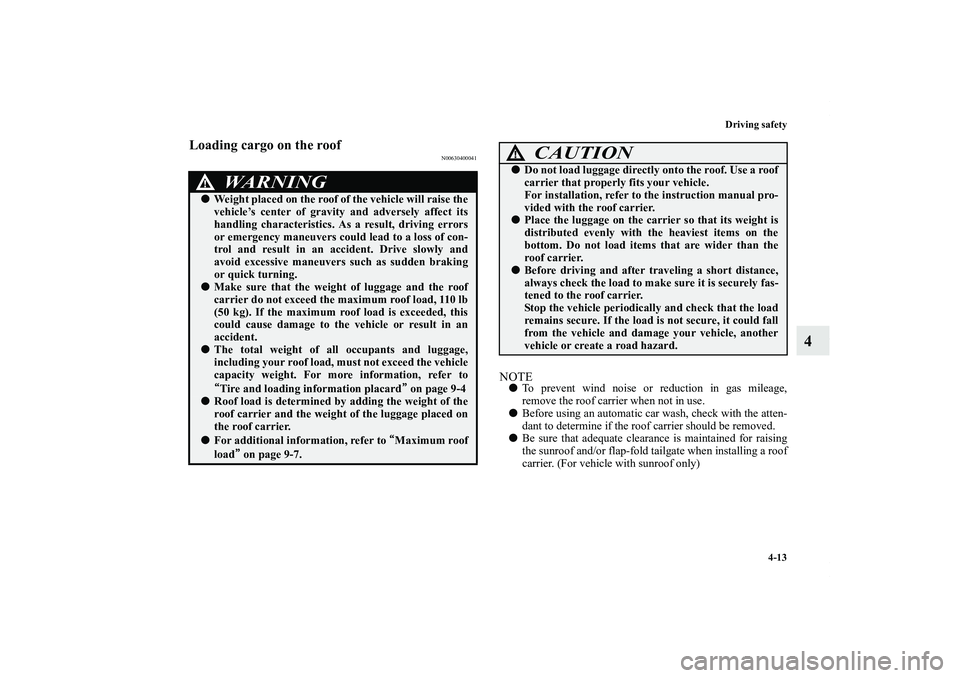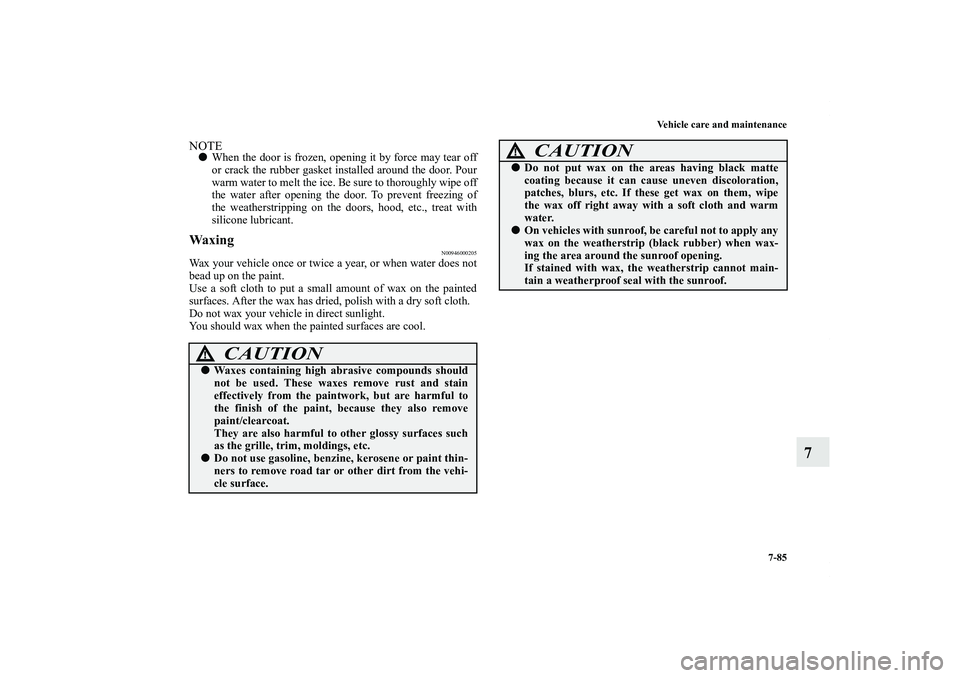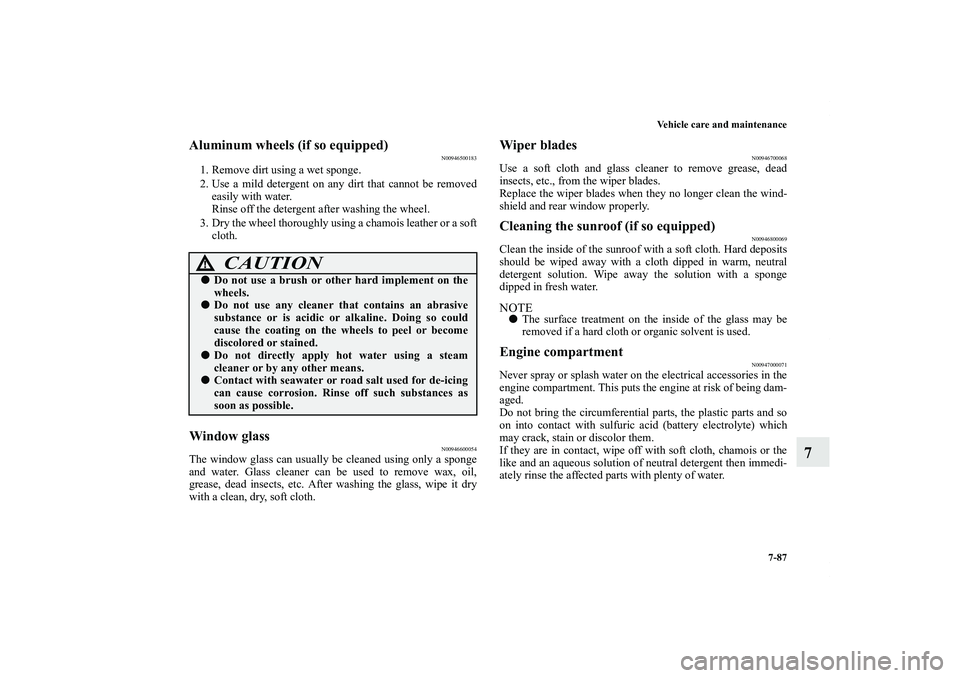Page 416 of 714

Driving safety
4-13
4
Loading cargo on the roof
N00630400041
NOTE�To prevent wind noise or reduction in gas mileage,
remove the roof carrier when not in use.
�Before using an automatic car wash, check with the atten-
dant to determine if the roof carrier should be removed.
�Be sure that adequate clearance is maintained for raising
the sunroof and/or flap-fold tailgate when installing a roof
carrier. (For vehicle with sunroof only)
WA R N I N G
!�Weight placed on the roof of the vehicle will raise the
vehicle’s center of gravity and adversely affect its
handling characteristics. As a result, driving errors
or emergency maneuvers could lead to a loss of con-
trol and result in an accident. Drive slowly and
avoid excessive maneuvers such as sudden braking
or quick turning.�Make sure that the weight of luggage and the roof
carrier do not exceed the maximum roof load, 110 lb
(50 kg). If the maximum roof load is exceeded, this
could cause damage to the vehicle or result in an
accident.�The total weight of all occupants and luggage,
including your roof load, must not exceed the vehicle
capacity weight. For more information, refer to
“
““ “Tire and loading information placard”
”” ” on page 9-4�Roof load is determined by adding the weight of the
roof carrier and the weight of the luggage placed on
the roof carrier.�For additional information, refer to “
““ “Maximum roof
load”
”” ” on page 9-7.
CAUTION
!�Do not load luggage directly onto the roof. Use a roof
carrier that properly fits your vehicle.
For installation, refer to the instruction manual pro-
vided with the roof carrier.�Place the luggage on the carrier so that its weight is
distributed evenly with the heaviest items on the
bottom. Do not load items that are wider than the
roof carrier.�Before driving and after traveling a short distance,
always check the load to make sure it is securely fas-
tened to the roof carrier.
Stop the vehicle periodically and check that the load
remains secure. If the load is not secure, it could fall
from the vehicle and damage your vehicle, another
vehicle or create a road hazard.
BK0122500US.book 13 ページ 2010年5月12日 水曜日 午前11時11分
Page 642 of 714
Vehicle care and maintenance
7-45
7
Passenger compartment fuse location tablePassenger compartment fuse location
Sub fuse block Main fuse block
No.
Symbol
Electrical system
Capacity
1 Heater 30 A*
2Stop lights
(Brake lights)15 A
3 Rear fog light 10 A
4 Windshield wiper 30 A
5 Optional 10 A
6Door locks20 A
7Radio15 A
8 Control unit relay 7.5 A
9Interior lights
(Dome lights)15 A
10 Hazard warning flasher 15 A
11 Rear window wiper 15 A
12 Gauges 7.5 A
13Cigarette lighter
/Accessory socket15 A
14Ignition
Switch10 A
15 Sunroof 20 A
16 Outside rearview mirrors 10 A
17 All-wheel drive system 10 A
BK0122500US.book 45 ページ 2010年5月12日 水曜日 午前11時11分
Page 682 of 714

Vehicle care and maintenance
7-85
7
NOTE�When the door is frozen, opening it by force may tear off
or crack the rubber gasket installed around the door. Pour
warm water to melt the ice. Be sure to thoroughly wipe off
the water after opening the door. To prevent freezing of
the weatherstripping on the doors, hood, etc., treat with
silicone lubricant.Waxi n g
N00946000205
Wax your vehicle once or twice a year, or when water does not
bead up on the paint.
Use a soft cloth to put a small amount of wax on the painted
surfaces. After the wax has dried, polish with a dry soft cloth.
Do not wax your vehicle in direct sunlight.
You should wax when the painted surfaces are cool.
CAUTION
!�Waxes containing high abrasive compounds should
not be used. These waxes remove rust and stain
effectively from the paintwork, but are harmful to
the finish of the paint, because they also remove
paint/clearcoat.
They are also harmful to other glossy surfaces such
as the grille, trim, moldings, etc.�Do not use gasoline, benzine, kerosene or paint thin-
ners to remove road tar or other dirt from the vehi-
cle surface.
�Do not put wax on the areas having black matte
coating because it can cause uneven discoloration,
patches, blurs, etc. If these get wax on them, wipe
the wax off right away with a soft cloth and warm
water.�On vehicles with sunroof, be careful not to apply any
wax on the weatherstrip (black rubber) when wax-
ing the area around the sunroof opening.
If stained with wax, the weatherstrip cannot main-
tain a weatherproof seal with the sunroof.
CAUTION
!
BK0122500US.book 85 ページ 2010年5月12日 水曜日 午前11時11分
Page 684 of 714

Vehicle care and maintenance
7-87
7
Aluminum wheels (if so equipped)
N00946500183
1. Remove dirt using a wet sponge.
2. Use a mild detergent on any dirt that cannot be removed
easily with water.
Rinse off the detergent after washing the wheel.
3. Dry the wheel thoroughly using a chamois leather or a soft
cloth.Window glass
N00946600054
The window glass can usually be cleaned using only a sponge
and water. Glass cleaner can be used to remove wax, oil,
grease, dead insects, etc. After washing the glass, wipe it dry
with a clean, dry, soft cloth.
Wiper blades
N00946700068
Use a soft cloth and glass cleaner to remove grease, dead
insects, etc., from the wiper blades.
Replace the wiper blades when they no longer clean the wind-
shield and rear window properly.Cleaning the sunroof (if so equipped)
N00946800069
Clean the inside of the sunroof with a soft cloth. Hard deposits
should be wiped away with a cloth dipped in warm, neutral
detergent solution. Wipe away the solution with a sponge
dipped in fresh water.NOTE�The surface treatment on the inside of the glass may be
removed if a hard cloth or organic solvent is used.Engine compartment
N00947000071
Never spray or splash water on the electrical accessories in the
engine compartment. This puts the engine at risk of being dam-
aged.
Do not bring the circumferential parts, the plastic parts and so
on into contact with sulfuric acid (battery electrolyte) which
may crack, stain or discolor them.
If they are in contact, wipe off with soft cloth, chamois or the
like and an aqueous solution of neutral detergent then immedi-
ately rinse the affected parts with plenty of water.
CAUTION
!�Do not use a brush or other hard implement on the
wheels.�Do not use any cleaner that contains an abrasive
substance or is acidic or alkaline. Doing so could
cause the coating on the wheels to peel or become
discolored or stained.�Do not directly apply hot water using a steam
cleaner or by any other means.�Contact with seawater or road salt used for de-icing
can cause corrosion. Rinse off such substances as
soon as possible.
BK0122500US.book 87 ページ 2010年5月12日 水曜日 午前11時11分
Page 709 of 714

Alphabetical index
6Reporting Safety Defects 8-3
Roof antenna 5-134
,5-135
S
Safe driving techniques 4-5
S-AWC (Super-All Wheel Control) 3-116
Seat belt 2-39
Adjustable seat belt shoulder anchor 2-45
Child restraint systems 2-50
Front passenger seat belt warning light 2-44
Maintenance and inspection 2-61
Seat belt extender 2-47
Seat belt force limitter 2-50
Seat belt pre-tensioners 2-48
Seat belt use during pregnancy 2-48
Seat belts
Seat belt extender 2-47
Seats 2-2
Arm rest 2-15
Front seats 2-5
Head restraints 2-26
Heated seat 2-11
Making a cargo area 2-29
Making a flat seat 2-35
Seat arrangement 2-3
Seats and restraint systems 2-5
Second row seats 2-13
Third row seat 2-16
Service brake 3-127Service precautions 7-2
Side turn-signal light
Bulb capacity 7-51
Snow tires 7-33
Spark plugs 7-36
Steering
Power steering fluid 7-21
,9-11
Tilt lock lever 3-81
Wheel lock 3-32
,3-89
Stop lights
Bulb capacity 7-51
Replacement 7-68
Storage spaces 3-272
Sun visors 3-265
Sunroof 3-76
Super-all wheel control (S-AWC)
S-AWC control mode display 3-118
S-AWC control mode switch 3-117
S-AWC operation display 3-119
S-AWC warning display 3-120
Supplemental Restraint System 2-61
How the Supplemental Restraint System works 2-65
Maintenance service 2-84
T
Tail light
Bulb capacity 7-51
Replacement 7-68
Tailgate 3-60
BK0122500US.book 6 ページ 2010年5月12日 水曜日 午前11時11分